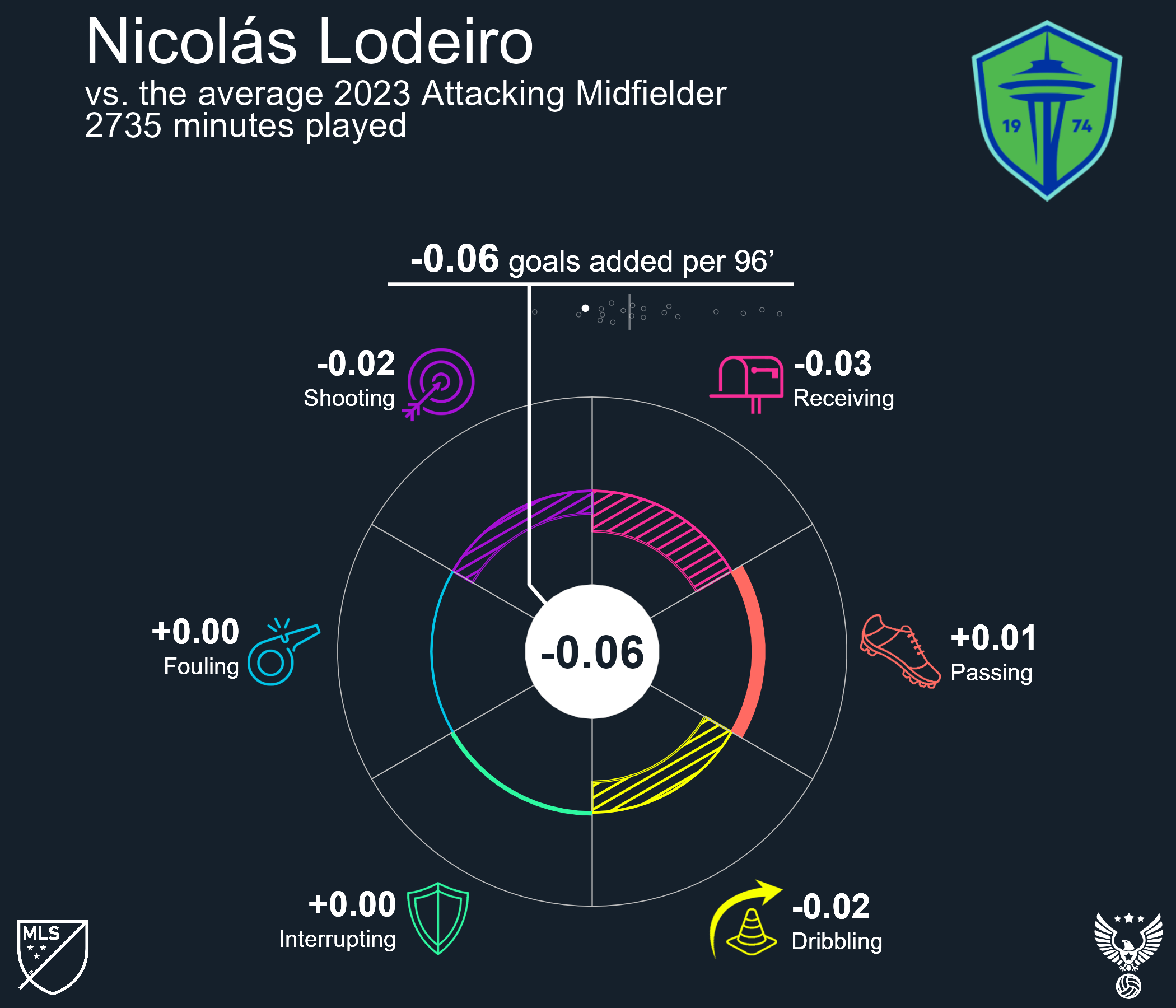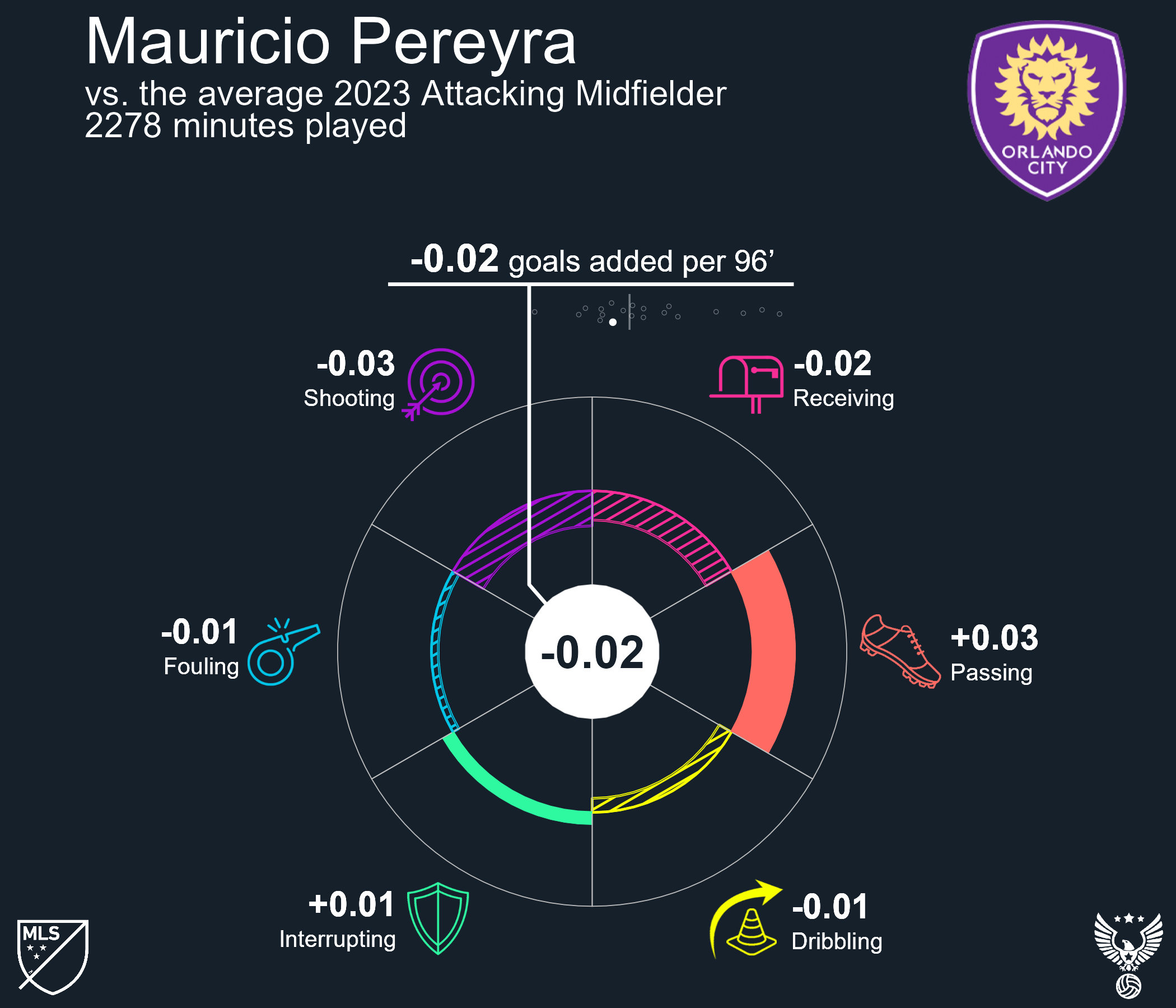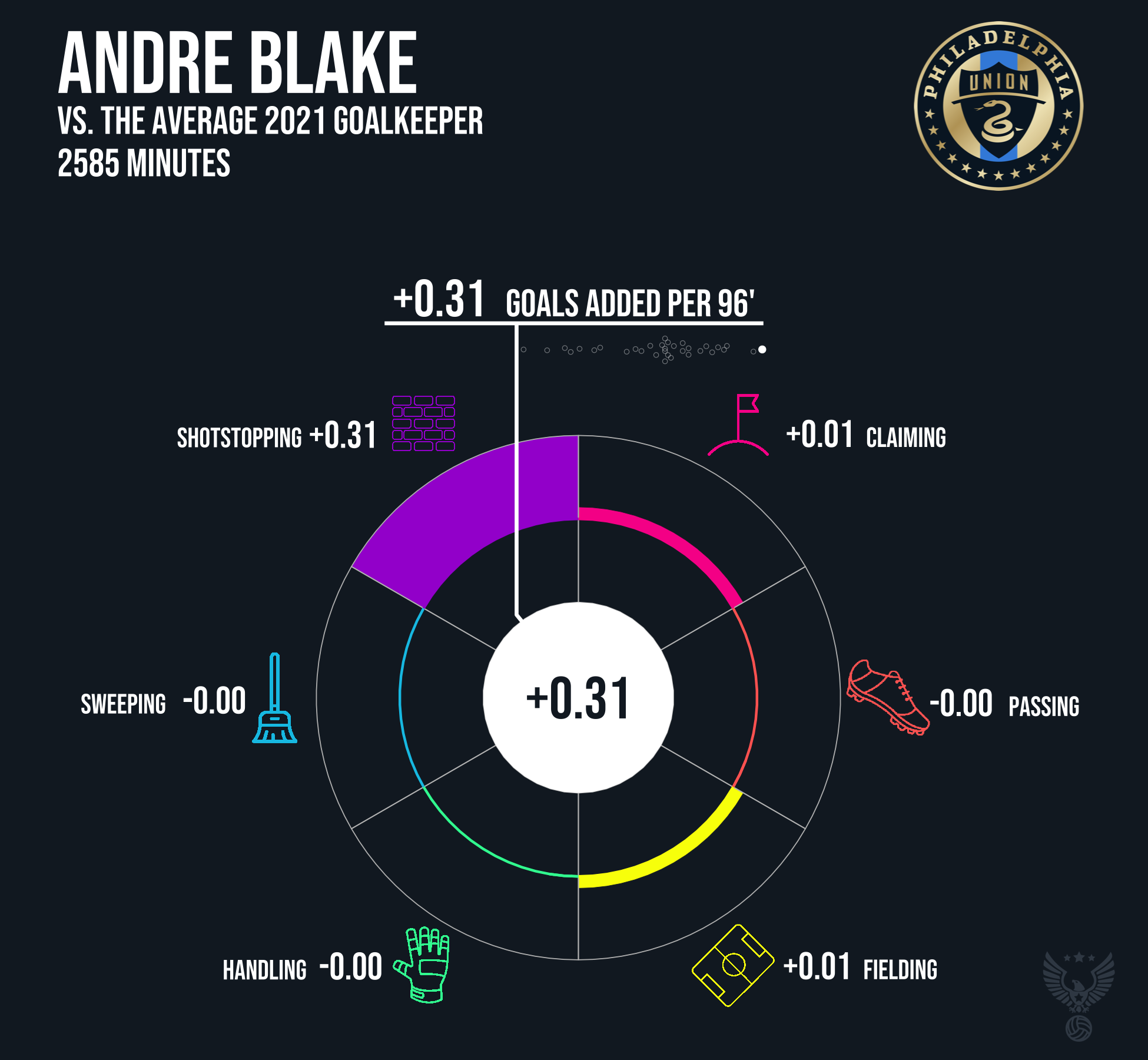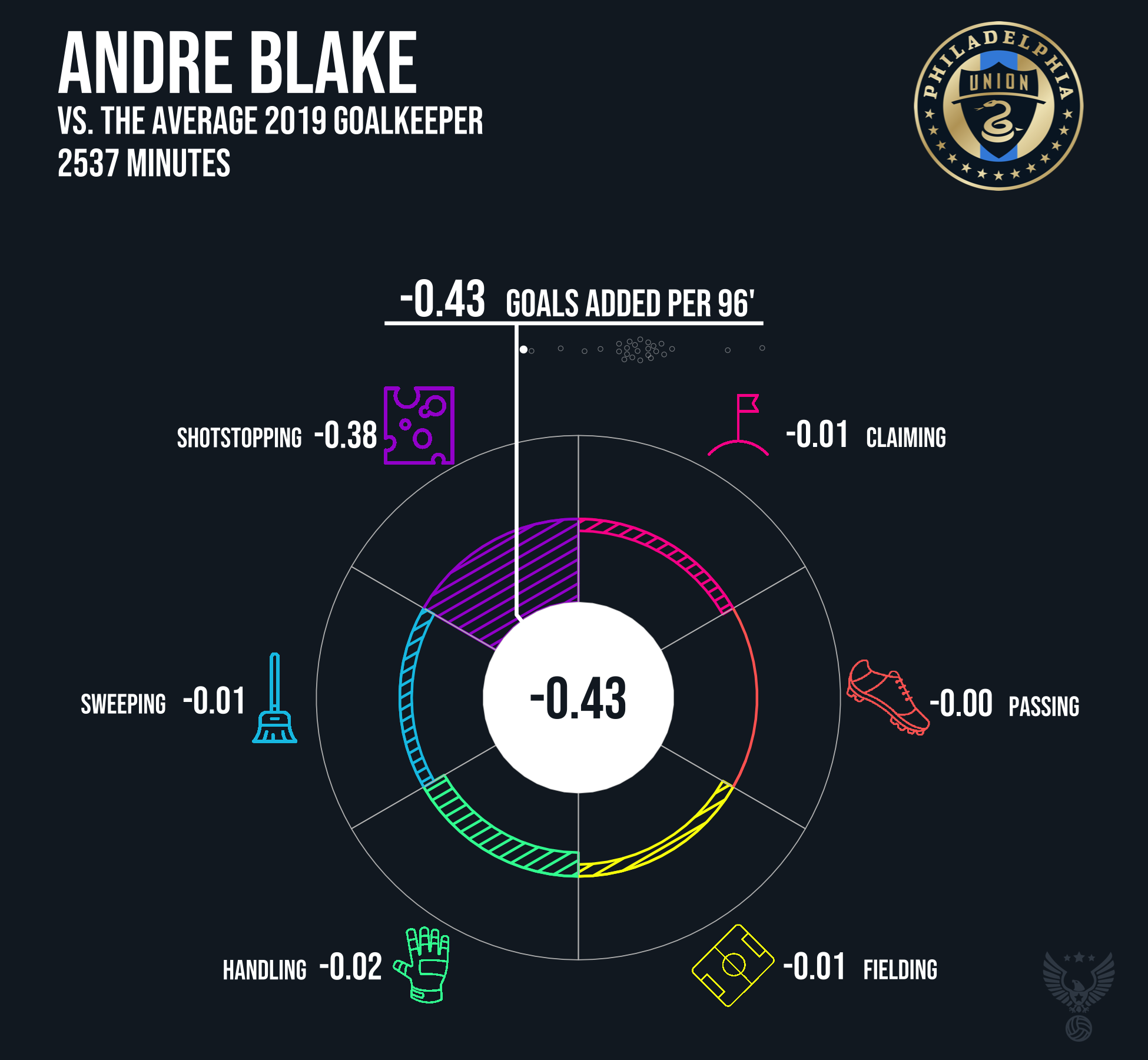Season Previews: Orlando, Philly, St. Louis City
/Will Orlando’s Outliers Overperform Once More?
How do you follow-up your best-ever season? Orlando City might have the answer. Orlando finished 2023 second in the East (and second in MLS) with a club-record 63 points, scoring a club-record 55 goals along the way. After a best-ever playoff finish in the Eastern semifinals, the Orlando front office may have had a best-ever off-season:
Keeping rookie standout Duncan McGuire for the MLS minimum rookie salary after his $4 million deal with Blackburn collapsed at the final hurdle,
Signing Luis Muriel, a designated player also valued at $4 million, for a $1 million steal from Atalanta, and
Adding two more headline signings in attack (Nicolas Lodeiro) and defense (David Brekalo) that will provide tangible contributions to a team already firing on all cylinders.
Can the Lions ride this positive momentum to another best-ever finish in 2024?
Replicating McGuire’s Magic Is Unsustainable
Orlando’s 2023 campaign saw them finish second on the table with a club-record 63 points, smashing their previous best by 12 points. The Lions demonstrated commanding efficiency in attack, scoring 55 regular season goals (7th in MLS) off chances expected to score 42 (16th in MLS).
Top-shelf performance off of bottom-tier underlying numbers? Welcome to Orlando, where analytics doesn’t exist.
This incredible attacking execution was led by a breakout rookie Duncan McGuire, who scored 13 goals off a mind-boggling 5.6 xG. In other words, McGuire scored seven-and-a-half goals more than he should have, an over-performance placing him in third all-time on a list with some hefty names. Not bad for a rookie. Luckily for Orlando, even his underlying numbers are totally solid production for a league minimum Super Draft pick.
After reviewing his mixtape, McGuire’s outstanding shooting comes less from amazing individual talent and more from an elite reading of space in transition. McGuire effectively attacked space left by defenders drawn to one of Orlando’s prolific attacking midfielders. This outstanding receiving is noted in McGuire’s g+ wheel, where receiving stands out especially compared to the rest of his front four. There are a few points to take away from this:
Mathematical improbability aside, there are two reasons why Orlando should not count on another expectations-defying season like this.
First, McGuire is likely not staying long. Time is not on Orlando’s side: McGuire’s outstanding proficiency is bound to revert to the mean soon enough. As a 23-year-old rookie with a $4 million valuation, McGuire’s agent is making noise for a move as soon as possible. Hopefully they and Orlando can find a club with a front office that can locate the “Submit” button.
Second, Luis Muriel has a significantly more on-ball skillset. Outstanding receiving requires an ability to lurk in the shadows and strike open space with speed. Luis Muriel can do this, he’s a 99th percentile progressive passes received guy. But that’s not all he is. According to his scouting report and his season mixtapes, Muriel commands attention on the ball with his 98th percentile touch-count and shot-creation skills. This profile reads more as a forward as likely to feed McGuire (or Facundo Torres or Martin Ojeda) as running on the end of through balls.
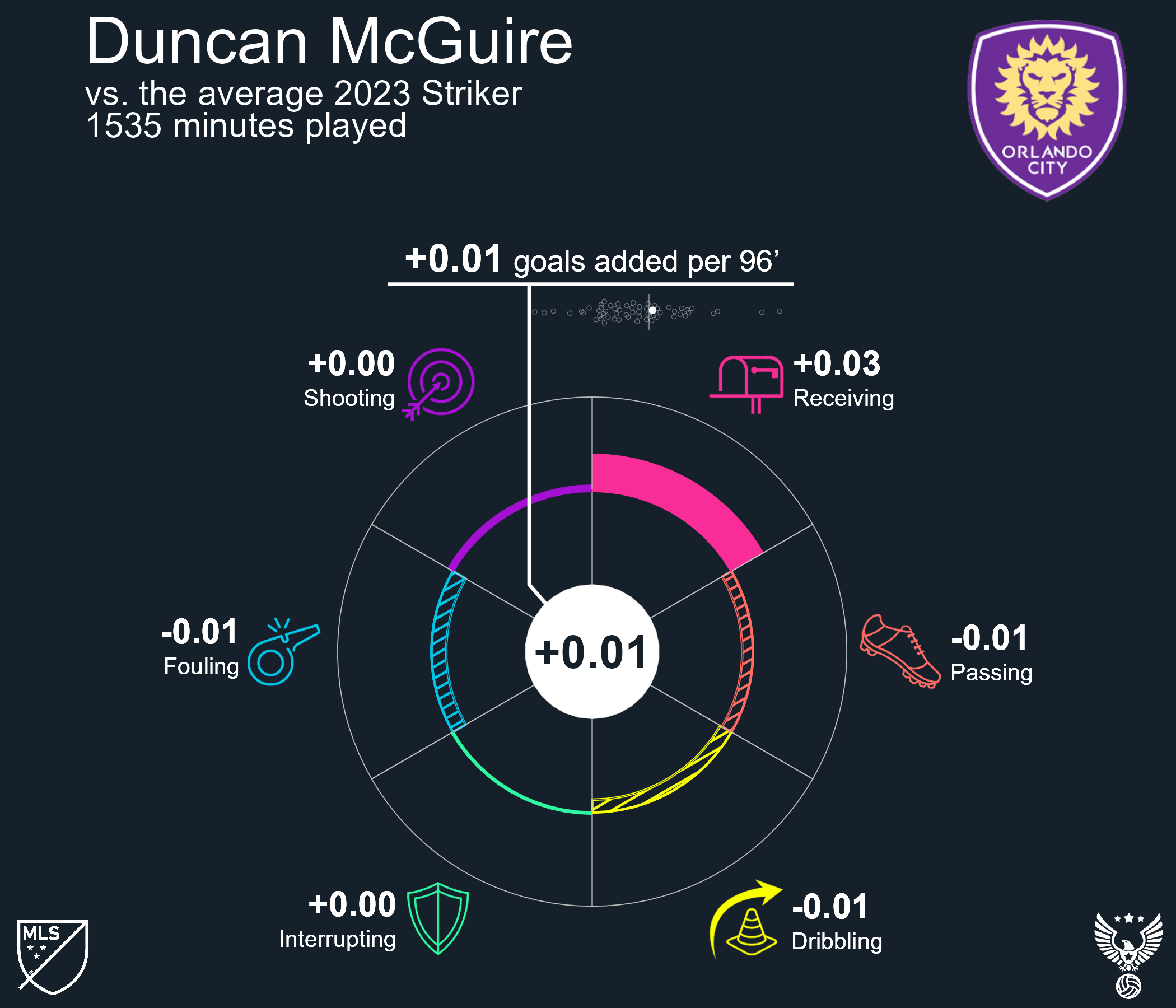
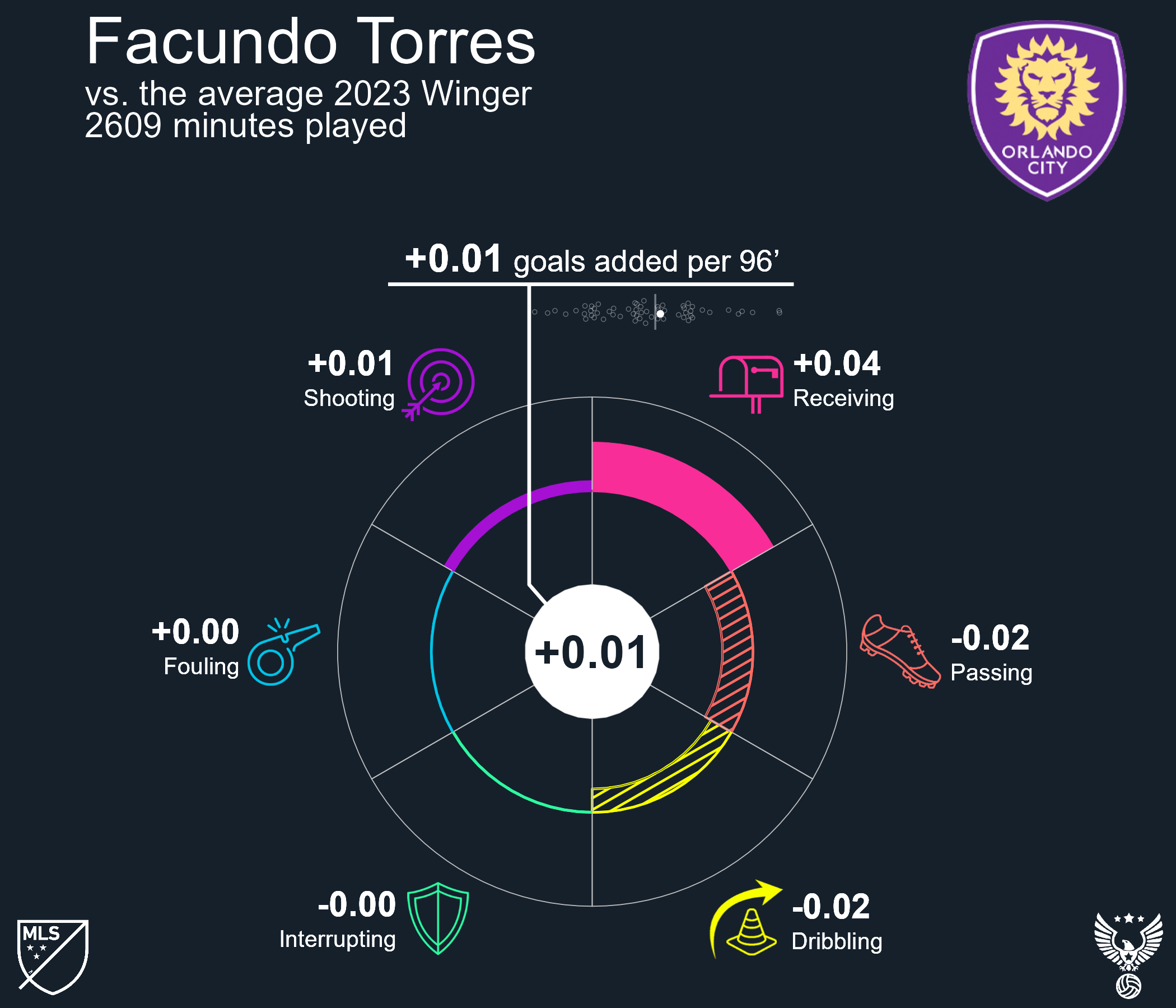
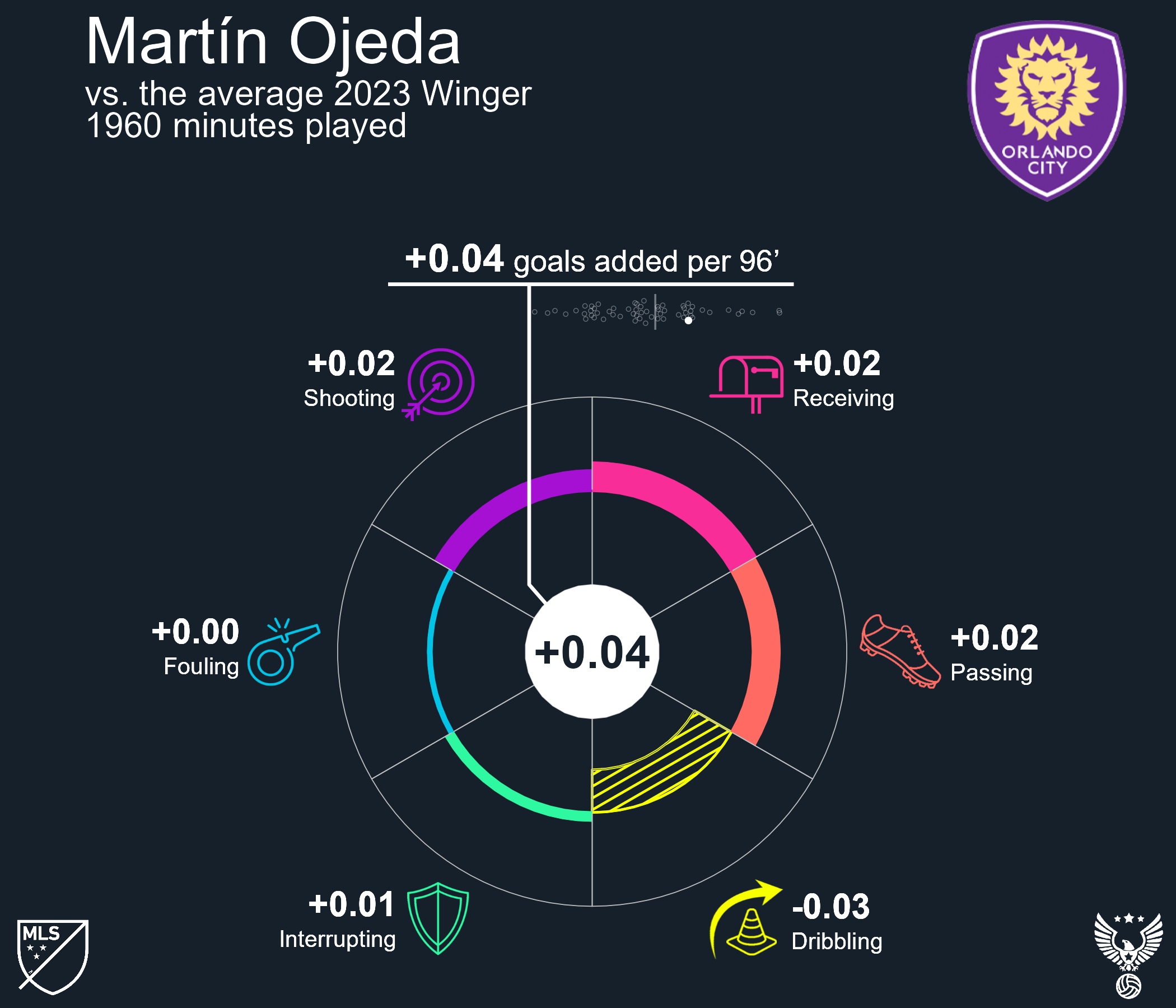
Designated players Facundo Torres and Martin Ojeda also seem like willing receivers, and will be called upon to increase their attacking output in 2024.
Instead, Orlando Will Need To Pump Up The Attacking Volume
The best way Orlando can hedge against expectations is to rack up more shots. Orlando scored their 55 goals off 402 created shots. This is 20 shots below the 2023 MLS average, and actually fewer than their 410 shots conceded for 2023. Headline transfers Nicolas Lodeiro and Luis Muriel will be instrumental in turning up the Lions’ attacking volume.
With 48 shots and 62 key passes in 2023, Nicolas Lodeiro matched designated player attackers Facundo Torres and Martin Ojeda in terms of shot involvements. He will be a demonstrable improvement over outgoing Mauricio Pereyra, who struggled to get shots off. Lodeiro’s increase in quality also nets two more goals in terms of both shots (xG) and key passes (xA) as well.
More worrying, however, is Luis Muriel’s differences in quality over the past three years. After peak output seasons in both 2020/2021 (where he had a similar explosion of 22 goals off 15.5 xG) and 2021/2022, Luis Muriel struggled to find the field in 2022/2023 (1,000 minutes) and this current Serie A season (408 minutes). Orlando does have a deep glut of creative attackers, but only one at the striker spot. They will need him to be healthy.
Can Robin Jansson Get Some Help in Defense?
Orlando had an outstanding 2023 defense, conceding 39 goals off 41 xG and 410 shots. Robin Jansson headlined the defense, turning in a defender-of-the-year caliber performance at center-back.
Having a standout individual defender can be a backhanded compliment of sorts, especially when that defender is the last line before the goalkeeper. It naturally asks what vulnerabilities across the team defense required one of the best defensive efforts in the league.
Using ASA’s defensive goals-subtracted metric, the Orlando defense was a relatively average team without Robin Jansson.
Antonio Carlos acquitted himself well as Jansson’s center-back partner, but injury saw him struggle to see the field. He has also departed for Fluminense in the offseason. Cesar Araujo and Rodrigo Schlegel performed admirably to cover for Antonio Carlos during his injury, but both also hover around the expected average for their position groups.
New signing center-back David Brekalo will have his work cut out for him. The Slovenian was a regular starter in Norway’s top flight for fourth-place Viking FK, but his individual scouting report remains thin. Orlando’s defensive performance in the 2024 season may very well depend on how he adapts to MLS, especially if Jansson were to fall injured.
Verdict: Can Orlando Hold Onto Its Best-Ever Momentum?
Orlando City definitely reads as a playoff contender on paper, maybe even an Eastern Conference finalist should the stars align. However Orlando’s outstanding performances relied too much on individual outliers, which is a risky bet. Whether Orlando can keep the best-ever momentum going will be up to how they answer the open questions in their attack and defense.
Forget it, Jake, it’s the Union
Robert Towne’s Chinatown is considered one of the great movie scripts of all time. The closing line in particular is a classic in subtext. A policeman icing-ly tells Jack Nicholson’s character Jake to “forget it, it’s Chinatown”. What is really being said is that the common man, despite best efforts, is powerless against the evil forces that rule the world.
And while it goes without saying the Philadelphia Union aren’t remotely evil, their actions confound fans who seem powerless to understand, let alone influence, their activity.
Before exploring the Union’s offseason subtext, let’s recap a solid 2023 campaign. The Union completed a grueling 51 game schedule and acquitted themselves well in all major competitions. They made three semifinals - CONCACAF Champions Cup, Leagues Cup and MLS Eastern Conference - and qualified for this year’s version of the Champions Cup. They came up short in those big matches but showed their top team has enough quality to compete with anyone in the region.
So, the Union are right there. They have a great starting XI but very little in terms of experienced depth. Heading into 2024, that would be an obvious place to start. It didn’t happen. In fact, something else entirely happened.
The Text
At the end of last season’s press conference, Sporting Director Ernst Tanner noted that the Union have the 4th lowest salary budget in the league. He then remarked, “We are constantly outperforming this, and that is something we need to acknowledge and respect.”
The Subtext
While Tanner spun this in a positive light, he let everyone know right away that the salary budget issue is not about to magically disappear. But that still leaves the key question on the table: why is the Union spending so low? Philadelphia is not only one of the largest cities in the country but a massive sports town. Forbes recently ranked them as the 13th most valuable franchise in the league, which hints they must have more going for them financially than most clubs.
Image from steve fenn (@stathunting on twitter)
They’ve also been much more of a seller than a buyer. They’ve made nice gains on Brenden Aaronson, Mark McKenzie, and Paxton Aaronson over the years and currently have the league’s lowest “highest ever transfer fee paid,” which went for forward Michael Uhre. They’ve taken in a fair amount of fees, and haven’t sent much out.
Financially they seem to be doing just fine. But no one gets to know why they are unwilling to spend on the senior club. I took a crack at trying to rationalize it, but fans are told to acknowledge and respect that this is just part of Union life.
The Text Part 2
In the same presser Tanner spoke about the plan for 2024:
“What makes us strong is basically our player development, and in particular our young players. The next wave of homegrown players is now knocking at our doors, and we need to do our best job with them. That’s what we are going to stick with, and that’s what we’re going to foresee for the next season as well.”
The Subtext Part 2
What Tanner might have otherwise said: Despite an excellent starting squad, an amazing opportunity in the CONCACAF Champions Cup, and another grueling schedule, we are not going to materially invest in the squad and add experienced depth.
Fans naively expected the Union to act differently, but Tanner was true to his word. The Union were certainly active this offseason, but what they did was further cement the foundation of a youth movement. It’s startling when you look at the numbers.
Here’s a very fast run down of the new players signed since last July - Olwethu Makhanya (19), Tai Baribo (26), Sanders Ngabo (19), Nick Pariano (20), Isaiah LeFlore (21), Jamir Berdecio (21), Oliver Semmle (25), and Markus Anderson (20).
Hold out Baribo for a second, as he’ll be talked about below. Looking at the remainder of the activity, there’s practically zero top division, first team experience.
Here is the age distribution of the 15 players who will be competing for starting or bench minutes.
The average age off the bench is now 22.6. That outlier at the age of 30 is Damion Lowe, who was critical to last season’s success and remains the most senior reserve on the team. Removing Damion, the remaining bench has a total of 284 MLS matches under their belt, or about 20 per player, and almost all of that experience is tied up in five players.
Outside of amassing a strong starting XI, Tanner has since built an extremely young pipeline for the future. It smacks of a long term strategy, which any fan can appreciate, but what about this team now? The starting XI that has the skillset to compete at the highest levels. Shouldn’t there be some short term strategy? These questions can be asked, but there won’t be an answer.
The Keys to the Season
The Union have one of the strongest top 3’s in league with Michael Uhre, Julian Carranza and Daniel Gazdag. Carranza took a step forward last season, while Gazdag and Uhre took a step back from their 2022 campaigns, which brought the offense down to earth. Goals scored dropped from 72 to 57 between 2022 and 2023.
The key to the 2024 offense's success sits with the second oldest bench player Tai Baribo (26). He averaged .45 goals per game in the Austrian Bundesliga, and is paid in excess of $700K per year, but had an odd opening season with the Union. He only saw the pitch five times for a total of 151 minutes and managed a single shot on target. He seemed disconnected from the club and never really integrated. Given the level of investment and the grueling schedule ahead, he’ll need to be a difference maker for the offense to succeed. He is an important, if unknown, commodity.
The lower part of the midfield in the Union’s 4-4-2 diamond formation should continue to be a source of strength. Jose Martinez, Jack McGlynn, and Alejandro Bedoya offer a great mix of youth and experience, and this is where there is some solid, if unspectacular, depth. Leon Flach and Jesus Bueno are the most seasoned reserves, and will get significant minutes throughout the year. Homegrown Quinn Sullivan (19) also stands to get shuttler minutes and has shown an exciting array of skills at a young age. He is clearly one of the “young players” that Tanner was referencing.
The Union’s defense is very good. Just how good they will be will come down to how great Andre Blake performs. During the Union’s terrific 2022 run, the Union allowed just 26 goals, the 2nd lowest per game total in league history. They dramatically outperformed their expected goals allowed of 38, largely on the back of Blake’s best ever post shot expected goals allowed of 10.0. That means he saved 10.0 more goals than an average goalkeeper would have saved.
In 2023, Blake came back down to earth, but was still great. The team regressed and gave up 41 goals with an expected goals against figure of 44.2. Again, Blake drove that difference with a post shot expected goals against benefit of 4.1.
Expect the Union defense to be very solid again. But their level of greatness will be determined between the pipes. Blake has been one of the most inconsistent keepers by xG data across his time in MLS, holding both a top five and bottom five shot stopping season.
Here’s What We Know
The Union have a potentially great offense, a potentially great defense, and a grueling schedule. The concern is they just have two reserves that have proven they can contribute in critical moments - Damion Lowe and Leon Flach. Rather than solve that problem the Union have doubled down on their youth movement, signing six players under 22 years old since July.
Here’s What We Don’t Know
We don’t know why the Union are pushing toward youth when the senior team has the potential to push for trophies. We don’t understand why the owners insist they must have one of the lowest budgets in the league. We are simply told that player development is an important pillar of their strategy, when it’s hard to imagine that any club wouldn’t take that seriously.
At the end of last year, Union players complained about the length of the schedule and called for change. They were clearly tired as the season wound down. Purely conjecture, but the players might have offered a little subtext of their own in those comments. Perhaps that was a message to the ownership group as well: Get us more experience on the roster. We’re tired. The fans are powerless against the thick cement walls of the old Delaware County Power Plant, now Union headquarters. But perhaps the players are too.
There’s one more line from Chinatown that comes to mind, another one delivered to Jack Nicholson as he tries to unravel the mystery. “You may think you know what we’re dealing with, but, believe me, you don’t.”
And so it goes for the Union faithful as the 2024 season kicks off.
Don’t Call Me Austin
Hello Austin fans, it is I, your favourite team hater. Author of tweets such as “SCOREBOARD”, and “Dread it, run from it, the xG arrives all the same.” You remember me. I hope you’re all well. I’m here today to talk about your beloved Austin FC and their 2023 hopes, shall we?
Wait, this isn’t the Austin 2022 review and 2023 preview? It sure looks like it is! St. Louis City put up the 7th highest xGD overperformance in the entire ASA dataset, Austin were 4th. Much like Austin, they ran extremely hot the first half of the season, before finishing with three wins in their last twelve and being unceremoniously dumped in the playoffs. Regression comes for us all.
Unlike Austin, I don’t think St. Louis City have bought into the smell of their own farts particularly as much. Austin doubled down on a bad roster and Driussi being the second coming of Christ, and stayed bad. STL dumped Stroud and Bartlett for DCU’s Chris Durkin, sold Gioacchini for $2M to Como (who they got for $0 in the expansion draft, smart), and added fullbacks Nikolas Dyhr and Tomas Totland. It’s not exactly a statement of intent, but selling high and adding around the edges is a fairly safe, if underwhelming path.
How bad can it really be?
Let’s talk about regression. There are firstly, two sides of the ball to consider. STL were beating xG like a drum on both sides of the ball. On the defensive side, we can point at Roman Burki for that. Burki was the consensus pick for goalkeeper of the year, and smashed his PSxG/xGK/xGOT by somewhere between eight and ten goals depending on whose model you ask. That is awesome. I’m not going to tell you it’s not real and actually Burki is bad, what I am going to say is that Burki was about a career average Bundesliga goalkeeper. Now, Matt Turner and Djordje Petrovic have gone the other way to England and declined from unbelievably amazing MLS goalkeeper to something close to league average, and Gaga Slonina went from roughly league average to a somewhat bad Belgian league goalkeeper. Maybe that just is the league translation. Just something to keep your eye on in 2024.
On the flip side of the ball, I can say with extreme confidence that St. Louis will not have the attacking overperformance they did in 2023, again in 2024. They beat their xGF by 15 goals and there is no clear pattern or trend, not some career plus finisher milking a specific kind of chances, or some tactical plan to get more open chances than the xG models can infer. Just every single attacker beating their xG by one to four goals across the board. That sort of broad scale overperformance is a gigantic St. Louligans red flag waving in your face, it’s just not real. Add in teams actually and consistently passing your strikers the ball for breakaways, I would be remiss if I didn’t sound the regression klaxon here. Without some material change in how these players play (or the quality of their performances), don’t be surprised if that 60 goal attack is more like a 45 goal attack in 2024.
xPlace is the difference between post shot and pre shot xg models
Projecting for 2024
One reason to be optimistic for 2024 is that many of St. Louis’ best players were unavailable for big chunks of the season. Noted CB Jedi Mind Tricker Joao Klauss only racked up about 1500 minutes, Celio Pompeu and Aziel Jackson 1200 minutes, supposed-to-be-star CB Joakim Nilsson only 644 minutes. Jake Nerwinski put up a team worst -1.5 g+ above average and was a top three outfielder in minutes. Getting your best players on the field more often will obviously help (duh).
Another plus is the arrival of Dyhr and Totland from Mydtjylland and Häcken, respectively. Totland has been a Europa League level starter for a Häcken side that lost three times in two years at both fullback spots. Dyhr is more of a potential play, having been mostly unable to really break into the rotation at Mydtjylland, but it’s not like the bar to clear here is Anton Tinnerholm and Ryan Hollingshead. Here is the cavalcade of fullbacks St. Louis played more than 500 minutes in 2023: Anthony Markanich, John Nelson, Kyle Hiebert, Akil Watts, and Jake Nerwinski. That is not a list of good MLS fullbacks. Upgrading in these spots should offer a big benefit on both sides of the ball.
A nod to organizational structure
If those fullbacks don’t hit, it’s not a big deal. Their wages are low, and their fees were in the mid six figures. STL Sporting director Lutz Pfannenstiel, somewhat famously by this point, talked about “Designated Team” and not having loads of expensive DPs.
“The only reason our two DPs are DPs is because of the transfer fees, otherwise we wouldn’t have DPs. We believe in DT – Designated Team! Eleven players must make a difference, not one or two.”
One of the underrated upsides of this is the ability to move on from misses, and add on new attempted hits, extremely easily. Yes, they are returning nearly 80% of their raw goals added in what was a fine but not particularly good team who overperformed. But they’re not locked into any big salaries, there is no Insigne contract weighing them down. If the right player becomes a free agent in the summer, can they make the right move? If the right MLS name becomes available for a trade, are they in the mix? If in the two days between this coming out and Miami playing, they need to dump more salary are STL there to pick up a free lunch?
That’s what I will be watching for 2024. Yes, regression etc. but where do they go next?




